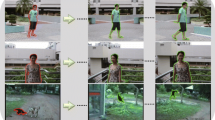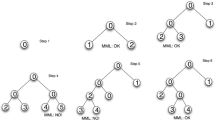Abstract
Efficient, interactive foreground/background segmentation in video is of great practical importance in video editing. This paper proposes an interactive and unsupervised video object segmentation algorithm named E-GrabCut concentrating on achieving both of the segmentation quality and time efficiency as highly demanded in the related filed. There are three features in the proposed algorithms. Firstly, we have developed a powerful, non-iterative version of the optimization process for each frame. Secondly, more user interaction in the first frame is used to improve the Gaussian Mixture Model (GMM). Thirdly, a robust algorithm for the following frame segmentation has been developed by reusing the previous GMM. Extensive experiments demonstrate that our method outperforms the state-of-the-art video segmentation algorithm in terms of integration of time efficiency and segmentation quality.
Similar content being viewed by others
References
Wang M, Hong R C, Li G D, Zha Z J, Yan S C, Chua T S. Event driven web video summarization by tag localization and key-shot identification. IEEE Transactions on Multimedia, 2012, 14(4): 975–985
O’Reilly R C, Wyatte D, Herd S, Mingus B, Jilk D J. Recurrent processing during object recognition. Frontiers in Psychology, 2013, 4: 124
Carreira J, Li F X, Sminchisescu C. Object recognition by sequential figure-ground ranking. International Journal of Computer Vision, 2012, 98(3): 243–262
Priya R, Shanmugam T N. A comprehensive review of significant researches on content based indexing and retrieval of visual information. Frontiers of Computer Science, 2013, 7(5): 782–799
Dong X, Wen J T. A pixel-based outlier-free motion estimation algorithm for scalable video quality enhancement. Frontiers of Computer Science, 2015, 9(5): 729–740
Yuan Y, Mou L C, Lu X Q. Scene recognition by manifold regularized deep learning architecture. IEEE Transactions on Neural Networks and Learning Systems, 2015, 26(10): 2222–2233
Lu X Q, Yuan Y, Zheng X T. Joint dictionary learning for change detection in multispectral imagery. IEEE Transactions on Cybernetics, 2016, 47(4): 884–897
Lu X Q, Li X L, Mou L C. Semi-supervised multitask learning for scene recognition. IEEE Transactions on Cybernetics, 2015, 45(9): 1967–1976
Huang Y C, Liu Q S, Metaxas D. Video object segmentation by hypergraph cut. Computer Vision and Pattern Recognition, 2009
Grundmann M, Kwatra V, Han M, Essa I. Efficient hierarchical graphbased video segmentation. In: Proceedings of IEEE Conference on Computer Vision and Pattern Recognition. 2010, 2141–2148
Brendel W, Todorovic S. Video Object Segmentation by Tracking Regions. In: Proceedings of the 12th IEEE International Conference on Computer Vision. 2009, 833–840
Dong L, Feng N, Zhang Q N. LSI: semantic label inference for nature image segmentation. Pattern Recognition, 2016
Vazquez-Reina A, Avidan S, Pfiter H, Miller E. Multiple hypothesis video segmentation from superpixel flows. In: Proceedings of European Conference on Computer Vision. 2010, 268–281
Lee Y J, Kim J, Grauman K. Key-segments for video object segmentation. In: Proceedings of IEEE International Conference on Computer Vision. 2011, 1995–2002
Boykov Y Y, Jolly M P. Interactive graph cuts for optimal boundary & region segmentation of objects in N-D images. In: Proceedings of the 8th IEEE International Conference on Computer Vision. 2011, 105–112
Chang X J, Nie F P, Ma Z G, Yang Y, Zhou X F. A convex formulation for spectral shrunk clustering. 2014, arXiv preprint arXiv:1411.6308
Liu H Q, Jiao L C, Zhao F. Non-local spatial spectral clustering for image segmentation. Neurocomputing, 2010, 74(1): 461–471
Jia J H, Liu B X, Jiao L C. Soft spectral clustering ensemble applied to image segmentation. Frontiers of Computer Science in China, 2011, 5(1): 66–78
Zhao F, Jiao L C, Liu H Q. Fuzzy c-means clustering with non local spatial information for noisy image segmentation. Frontiers of Computer Science in China, 2011, 5(1): 45–56
Bezdek J C, Ehrlich R, Full W. FCM: the fuzzy c-means clustering algorithm. Computers & Geosciences, 1984, 10(2–3): 191–203
Rother C, Kolmogorov V, Blake A. GrabCut-Interactive foreground extraction using iterated graph cuts. ACM Transactions on Graphics, 2004, 23(30): 309–314
Kohli P, Torr P H S. Dynamic graph cuts for efficient inference in markov random fields. IEEE Transactions on Pattern Analysis and Machine Intelligence, 2007, 29(12): 2079–2088
Szeliski R, Zabih R, Scharstein D, Veksler O, Kolmogorov V, Agarwala A, Tappen M F, Rother C. A comparative study of energy minimization methods for Markov random fields. In: Proceedings of European Conference on Computer Vision. 2006, 16–29
Boykov Y, Veksler O, Zabih R. Fast approximate energy minimization via graph cuts. IEEE Transactions on Pattern Analysis and Machine Intelligence, 2001, 23(11): 1222–1239
Boykov Y, Funka-Lea G. Graph cut and efficient N-D image segmentation. International Journal of Computer Vision, 2006, 70(2): 109–131
Li Y, Sun J, Shum H Y. Video object cut and paste. ACM Transactions on Graphics, 2005, 24(3): 595–600
Wang J, Bhat P, Colburn R A, Agrawala M, Cohen M F. Interactive video cutout. ACM Transactions on Graphics, 2005, 24(3): 585–594
Wang J J, Xu W, Zhu S H, Gong Y H. Efficient video object segmentation by graph-cut. In: Proceedings of IEEE International Conference on Multimedia and Expo. 2007, 496–499
Yang L, Wu X Y, Guo Y M, Li S B. An interactive video segmentation approach based on GrabCut algorithm. In: Proceedings of the 4th International Congress on Image and Signal Processing. 2011, 367–370
Talbot J F, Xu X Q. Implementing GrabCut. Provo, UT: Brigham Young University, 2006
Martin D, Fowlkes C, Tal D, Malik J. A database of human segmented natural images and its application to evaluating segmentation algorithms and measuring ecological statistics. In: Proceedings of IEEE International Conference on Computer Vision. 2001, 416–423
Xiang S M, Nie F P, Zhang C S. Semi-supervised classification via local spline regression. IEEE Transactions on Pattern Analysis and Machine Intelligence, 2010, 32(11): 2039–2053
Pan Y, Nie F P, Xu D, Luo J B, Zhuang Y T, Pan Y H. A multimedia retrieval framework based on semi-supervised ranking and relevance feedback. IEEE Transactions on Pattern Analysis and Machine Intelligence, 2011, 349(4): 723–742
Dong L, He L, Zhang Q N. Discriminative light unsupervised learning network for image representation and classification. In: Proceeding of the 23rd ACM International Conference on Multimedia. 2015, 1235–1238
Wang Z, Lu L G, Bovik A C. Video quality assessment based on structural distortion measurement. Signal Processing Image Communication, 2004, 19(2): 121–132
Blank M, Gorelick L, Shechtman E, IraniM, Basri R. Actions as spacetime shapes. IEEE Transactions on Pattern Analysis and Machine Intelligence, 2005, 29(12): 2247–2253
Reddy K, Shah M. Recognizing 50 human action categories of web videos. Machine Vision and Applications, 2013, 24(5): 971–981
Acknowledgements
This work was supported in part by the National Natural Science Foundation of China (Grant No. 61370149), in part by the Fundamental Research Funds for the Central Universities (ZYGX2013J083), and in part by the Scientific Research Foundation for the Returned Overseas Chinese Scholars, State Education Ministry.
Author information
Authors and Affiliations
Corresponding author
Additional information
Le Dong received the PhD degree in electronic engineering and computer science from Queen Mary University of London, UK in 2009. She is now an associate professor in University of Electronic Science and Technology of China, China. Her research interests include computer vision, big data analysis, and biologically inspired system.
Ning Feng is a PhD Student at University of Electronic Science and Technology of China, China. His major is computer science and technology, and his research interests are computer vision and image segmentation.
Mengdie Mao is an undergraduate from University of Electronic Science and Technology of China, China. Her major is computer science and technology, and her research interests focus on image retrieval and deep learning.
Ling He is an undergraduate from University of Electronic Science and Technology of China, China. Her major is computer science and technology, and her research interest is mainly in image classification.
Jingjing Wang received his master degree in University of Electronic Science and Technology of China, China in 2013. He is now working at Beijing Qihu Technology Company, China. His research interests are computer vision and image segmentation.
Electronic supplementary material
Rights and permissions
About this article
Cite this article
Dong, L., Feng, N., Mao, M. et al. E-GrabCut: an economic method of iterative video object extraction. Front. Comput. Sci. 11, 649–660 (2017). https://doi.org/10.1007/s11704-016-5558-7
Received:
Accepted:
Published:
Issue Date:
DOI: https://doi.org/10.1007/s11704-016-5558-7




